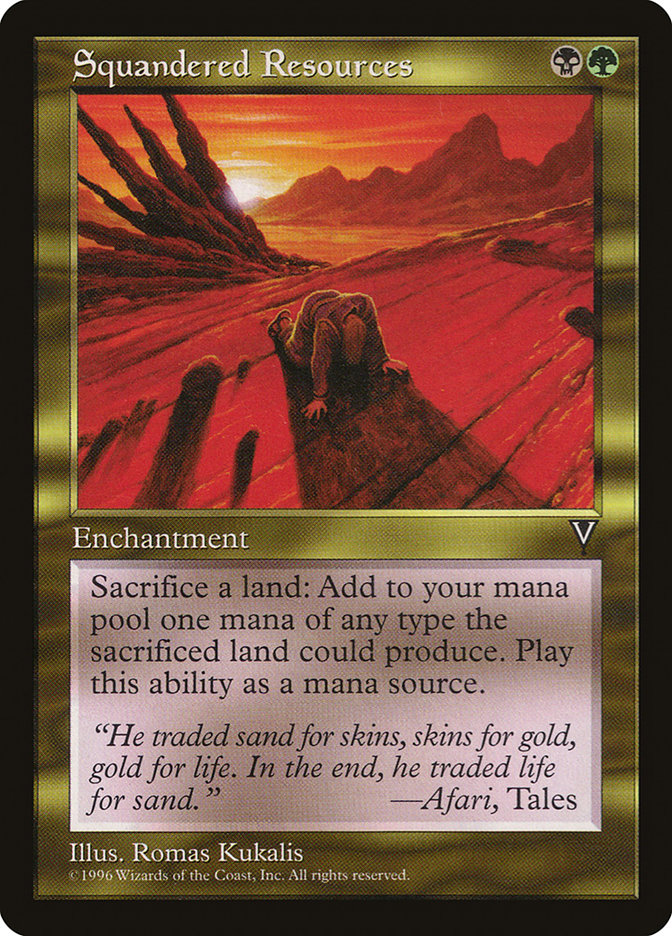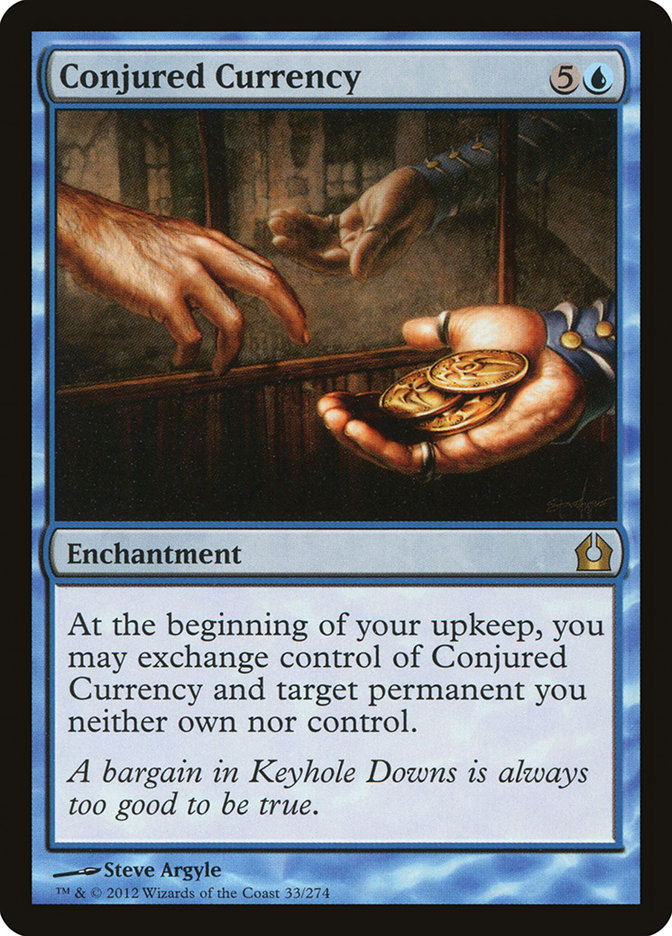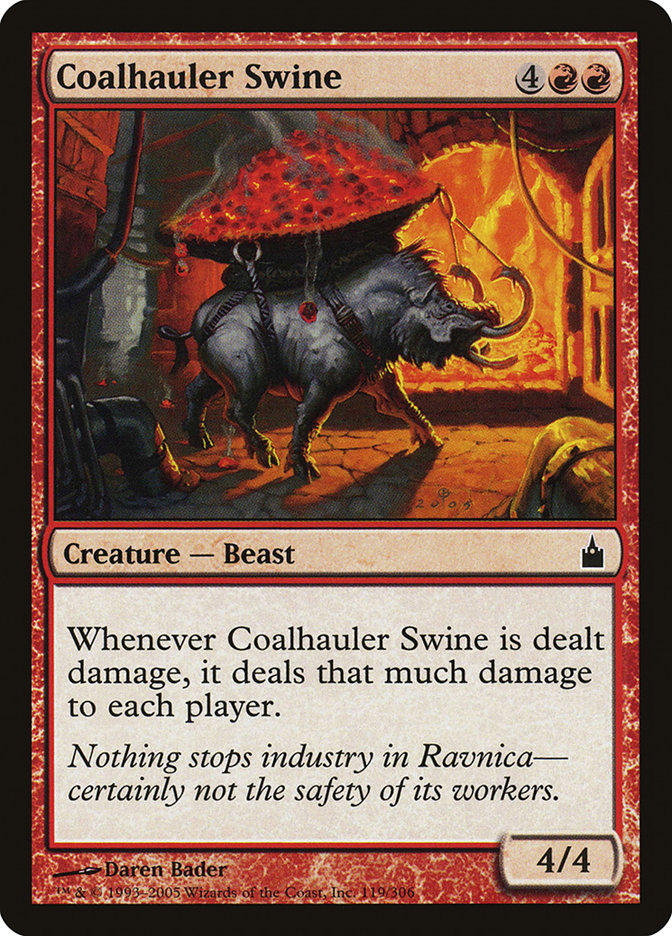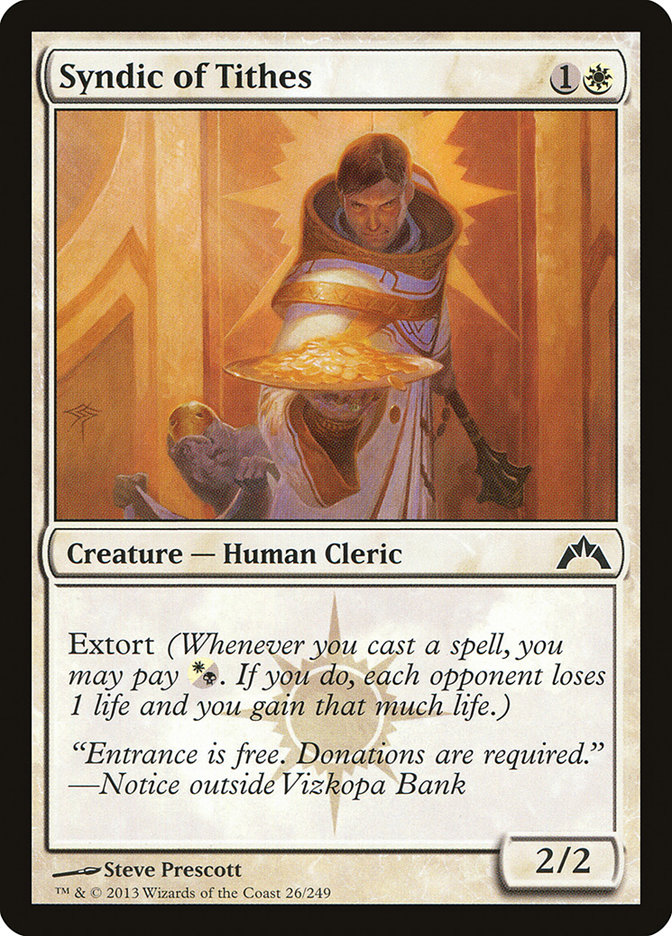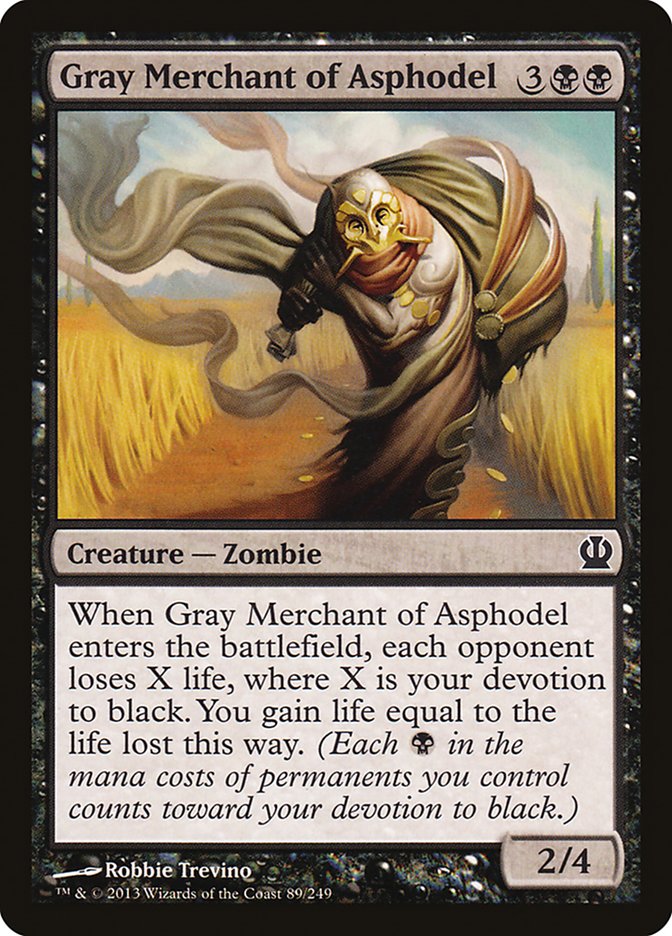A new setting for Magic: The Gathering means new cards to play with, new stories, and of course new fun. The Ancient Greece-inspired world of Theros has some players looking for powerful spells and others scrambling to find connections to mythology.
Me? I’m looking for coins.
Coins weren’t invented by the Greeks—one must go a little bit east to the kingdom of Lydia in present-day Turkey to find the traditionally held place of origin—but the city-states of Classical Greece, most notably Athens, raised money to an art form. Corinth, whose mythical hero-prince Bellerophon rode the Pegasus in many adventures, put the winged horse on many of its coins.

Silver tridrachm (three drachmae) coin of Corinth, Cabinet des Medailles, Paris. Image by Marie-Lan Nguyen, released to public domain.
I’m not just interested in coins because they’re pretty though. Coins and the money systems from which they derive also offer a window into how well a fantasy world has been constructed, using the amount of thought put into its economy as a proxy. (Diana Wynne Jones, author of The Tough Guide to Fantasyland, really changed how I think about worldbuilding as a reader and a creator.)
Gold coins shouldn’t come out of nowhere just because a certain time period of Western European history used gold coins, and ditto for silver, copper, or any other metal. Maybe you’ve heard of the island of Yap, where large round stones are used as a form of currency. Those stones came from a specific set of circumstances and are just as valid as a gold coin—or a five-dollar bill, or €480 in electronic form in a bank in Germany—within those circumstances.
Earlier settings for Magic: The Gathering usually don’t go beyond the most basic aspects of trade and money, with a few notable exceptions such as the money-grubbers of the Mercadia setting and the tale told on the card Squandered Resources.
In the two most recent settings for Magic, however, coins have received close-ups. After a brief look at the Innistrad setting and a more in-depth examination of the world of Ravnica, I’ll return to the new environment of Theros and how the information known at publication time point to the ways currency might be expressed there.
Innistrad and Methods of Manufacture
The all-around theme of the Innistrad setting is "Gothic horror," but there is a specific sense of place and time evoked as well: Prussia (specifically "18th century Prussia," per concept artist Steven Belledin). While the Innistrad setting takes obvious liberties with the source material, among others the presence of werewolves, when I saw the card Make A Wish, I took notice of the coin depicted, and it was off from what I expected.
I’m going to nitpick the Make A Wish illustration a little for a couple of reasons. First, it’s one of the few good close-ups of a coin in artwork for the game. Second, it lets me talk a bit about the history of money and some of the developments that shaped coins as you and I spend them.
In keeping with the "no gunpowder" general rule for Magic: The Gathering’s fantasy settings, there are no silver bullets in Innistrad, nor muskets to fire them. The overall level of technology, clothing aside, also seems to be lower than the target of "18th century Prussia." If that’s the case, though, then why is the coin perfectly round?
For most of the history of money, perfectly round coins have been the exception rather than the rule. Machine-made coins, called milled coinage, were adopted in most of Europe in the 1500s and 1600s, and 18th century Prussian coins did have that round character. What came before, however, were hammered coins, which are made exactly as the name sounds. Hammered coins usually have an irregular edge because the act of hammering a coin is so violent and unpredictable. Remember the tetradrachm? That’s a really well made coin for its time, and even it isn’t perfectly round.
If allowance is made for enough technology (and social stability!) to make milled coinage, the next question is why the edge is perfectly smooth.
One of the advantages of milled coinage is that it allowed a design to be placed on the edge. Before milled coinage, coins could have little bits of metal taken off the irregular edges without it being too obvious, a practice called clipping. Someone who did that to enough coins, especially silver or gold pieces, would end up with a nice stash of metal, which then could be used or sold; the problem popped up in medieval times as well as ancient.
If lettering or a design were placed on the edge, though, that made clipping almost impossible to pull off. U.S. quarters, to name just one example, have vertical bars on their edges because they were made of silver at one time.
Of course, there are any number of other explanations for the coin on Make A Wish. The edges could just be really worn down, it could be a counterfeit (sometimes counterfeit coins got spent a lot), and so on. I’ve nitpicked Make A Wish enough, though. The ecumenopolis of Ravnica offers more opportunities to talk about its money.
Zibs and Zinos: The Money of Ravnica
Ravnica, an entire world covered by a single city, has ten guilds that control most trade on its many, many streets. It is only fitting that such a civilized setting would have a certain emphasis on money. The card Conjured Currency gives a close-up to coins from the Dimir guild (or at least the illusion of coins from the Dimir guild, which is infamous for its secrets and lies), while the card Alms Beast, as I mentioned in an earlier article, evokes "company scrip" with its seemingly benevolent alms-coins that are redeemable only at stores owned by the Orzhov, a thoroughly corrupt guild known as the "Church of Deals."
Sixteen Tons: with the Church of Deals, you may well "owe your soul to the company store."
The most thorough accounting of Ravnica’s monetary system, however, comes from an official short story, "Rogue’s Passage" by Tom LaPille. In the story’s fourth paragraph, when the outside-the-law protagonist is making an inventory of his limited funds, the reader gets a glimpse not only of the various denominations of Ravnican coin, 100 zibs to a zino, but also some of the methods of coin debasement mentioned above that could be used by the unscrupulous and the desperate:
"Someone had shaved the edges of his Boros-made five zino coin, but not enough that most people would notice . . . The three one-zino coins were of Azorius mint and a relatively new design. The symbol extended higher off the face than it did on the older coins; someone with a sharp knife and a steady hand could probably shave it down, although he hadn’t seen anyone try it yet. There were also a few fifty and twenty-five zib pieces."
I don’t have a problem with the use of a decimal currency on Ravnica; while the pattern of denominations in tens is a relatively recent invention, the setting of Ravnica is meant to evoke Eastern Europe, and the first nation known to go "full decimal" was the Russian Empire in the early 1700s. An odd non-decimal system wouldn’t have surprised me either, but I’m ok with decimals.
There is a subtle clue, however, that the writer of the short story likely comes from a background in the Americas rather than Europe: the "twenty-five zib pieces." It would be far more natural for a writer living in the Eurozone to write of a "twenty zib piece" instead in correspondence with the twenty eurocent denomination, and the United Kingdom similarly uses a twenty pence coin.
Many countries in the Americas, however, have denominations influenced by the old Spanish system that was based fully on doubles and halves rather than powers of ten with halves and doubles in between. Spanish money was so pervasive on the early U.S.A. that it opted for a quarter dollar (the Spanish two reales—"two bits") rather than a twenty cent coin when it set up its own monetary system, and Spanish silver and gold coins were legal tender in the U.S.A. until 1857.
Also interesting: what has happened—or what the rogue contemplates doing—to the coins issued by the Boros and Azorius guilds. The Boros are a paramilitary organization of sorts, and while there is a long tradition of coin-manufacturing facilities following armies (so-called "traveling mints"), the results invariably were cruder than could be accomplished in stable, non-field conditions. It doesn’t take much of a logical leap to think that the coins of the Boros guild would be more vulnerable to tricks than those made by the money-grubbing Orzhov. The Azorius guild, dedicated to law and its administration, generally moves at a slow pace and takes its time, characteristics echoed in its carefully made coins with portraits in high relief.
Late in the "Rogue’s Passage" story, two gold coins from the Orzhov guild get a linguistic close-up: "They were both ten-zino pieces, of Orzhov mint, with pristine milled edges still intact." Because the setting of Ravnica has a strongly industrial flavor and there is a guild, the Izzet, specifically dedicated to progress and (non-firearm) technology, machine-made coins make sense, particularly from the guild most obsessed with them.
All this talk of coins, though, obscures another point. Where is the paper money?
Banknotes are roughly as old as machine-made coinage in Europe and even older in China. Paper money also goes hand-in-hand with the fractional reserve banking that can expand the money supply even when the underlying monetary base does not grow–and there is a good reason for that in Ravnica. Remember, the setting is an ecumenopolis, a single city covering an entire world, and gold coins are in use. New gold comes from mining…but when there are buildings covering all the ground, where can one mine?
For that matter, where does Ravnica get the coal that powers its industry? There is a guild dedicated to urban farming of a sort, the Golgari, but no miners’ guild.
The setting of Ravnica has been visited twice now. If it returns for a third engagement, perhaps those questions will get an answer.
Theros: What We Know and What I’d Like to See
Thanks to the Planeswalker’s Guide to Theros (in three parts: one, two, three), much of the basic information about the Greek myth-inspired setting has been released. There are several clues to its money and trade systems. While this place of isolated city-states does not have the same level of commerce as the Ravnica setting, it does have currency of multiple sorts.
Among the Underworld escapees known as "the Returned," gold isn’t valued—the Theros version of the Underworld god emphasizes the "god of wealth" aspect seen in mythology’s Pluto—and instead they use ostraka (singular ostrakon), shards broken from clay funeral masks, as currency. As far as customary money goes, the ostraka are on the poetic side, but I’ve read of stranger and not everything put in the Planeswalker’s Gude ends up getting expressed on a card or in a story. Certain of the Returned also have reason to handle the gold coins of the living, as seen in the illustration for the card Gray Merchant of Asphodel.
Among human settlements, there are three extant city-states—Meletis, Akros, and Setessa—with a fourth, Arixmetes, rumored to have existed once but also to have suffered an Atlantis-like catastrophe and crumbled into the sea. Leaving aside the possibility of an archaeological excavation or "lucky find" of a coin from Arixmetes, the three extant city-states each have their own personalities and views of the world that make coinage less or more likely.
Setessa, by the standards of a city-state, is naturally inclined. Its passage in the Planeswalkers’ Guide specifically states about the Abora Market, center of commerce: "Currency is not common, although foreign sellers sometimes accept coin." From what’s known, I find it doubtful Setessa issues its own coins, and seeing one depicted on a card seems far out of reach.
As Akros appears to be based strongly on Sparta with its emphasis on rigorous military culture, coins of Akros seem like a long shot as well. Sparta did not have coinage after the Laws of Lycurgus, which prohibited the Spartan citizens (whose males were also its elite soldiers) from working a trade and using gold and silver money, among other restrictions. The Akroans might have "iron rod money" in analogy to the Spartans, but I would not expect more.
Meletis, though . . . Meletis is the Athens equivalent in Theros. Arts. Culture. Philosophy. The most iconic coin of antiquity, the tetradrachm with the face of Athena, goddess of wisdom, on one side and her owl on the other. The tetradrachm was used in trade far beyond the borders of Athens, a defining mark of commerce and civilization. If a coin of Theros gets a close-up, its most likely form will be a silver or gold piece made by Meletis, and the face on it will belong to Ephara, the god of civilization of Theros.
***
For a player of Magic: The Gathering, this is a time of great excitement with new cards being revealed almost every day. I hope you’ve been inspired to do a little "coin hunting" of your own as you look through the cards in your collection and the ones that will be added to it soon.
As always, thanks for reading.
— JDB
@jdbeety on Twitter

